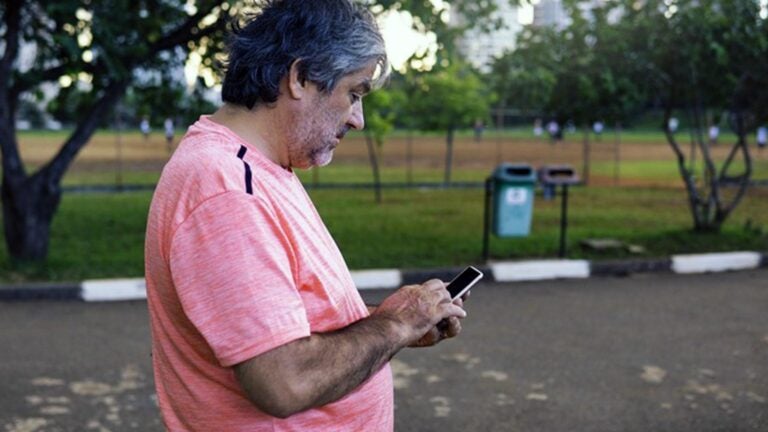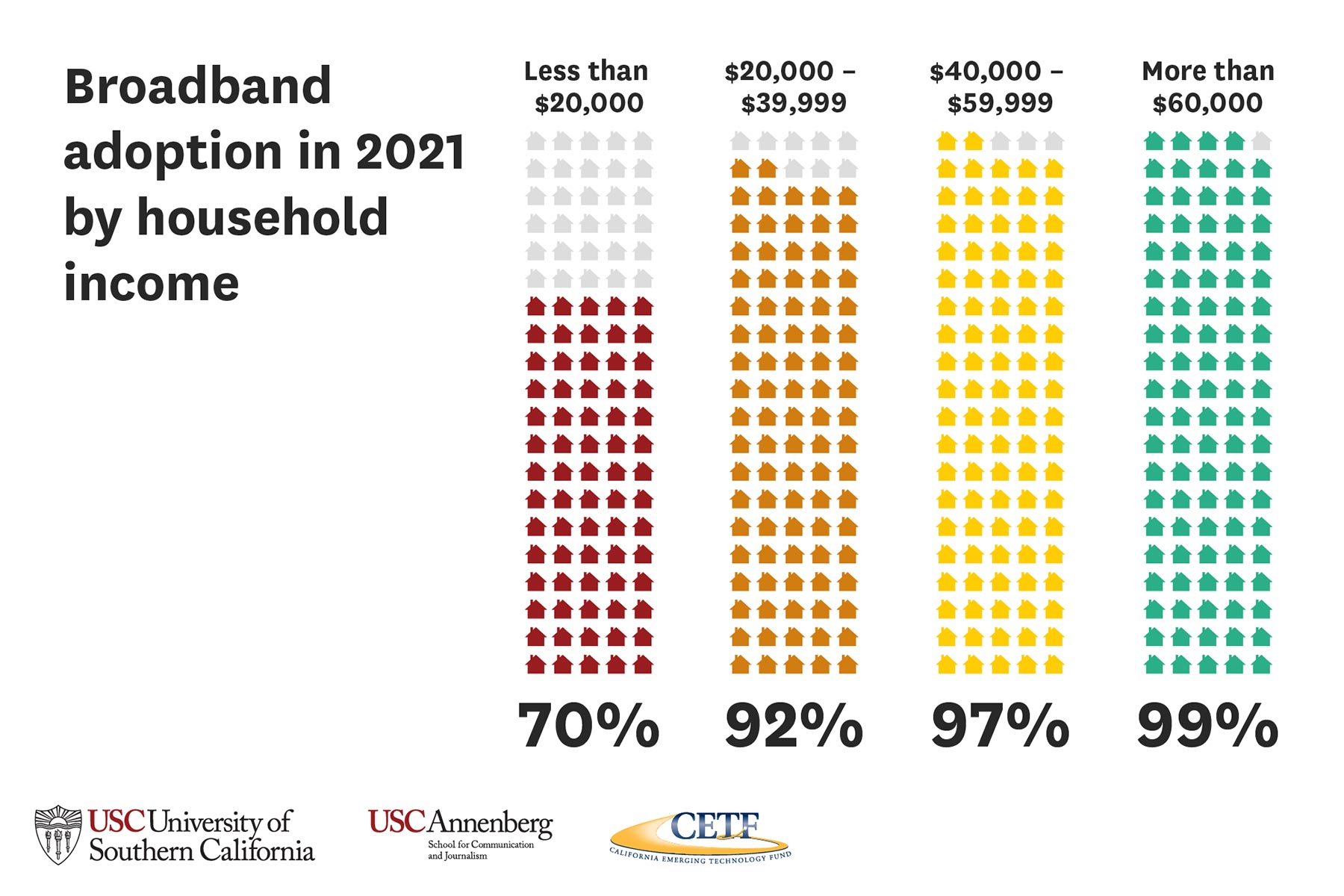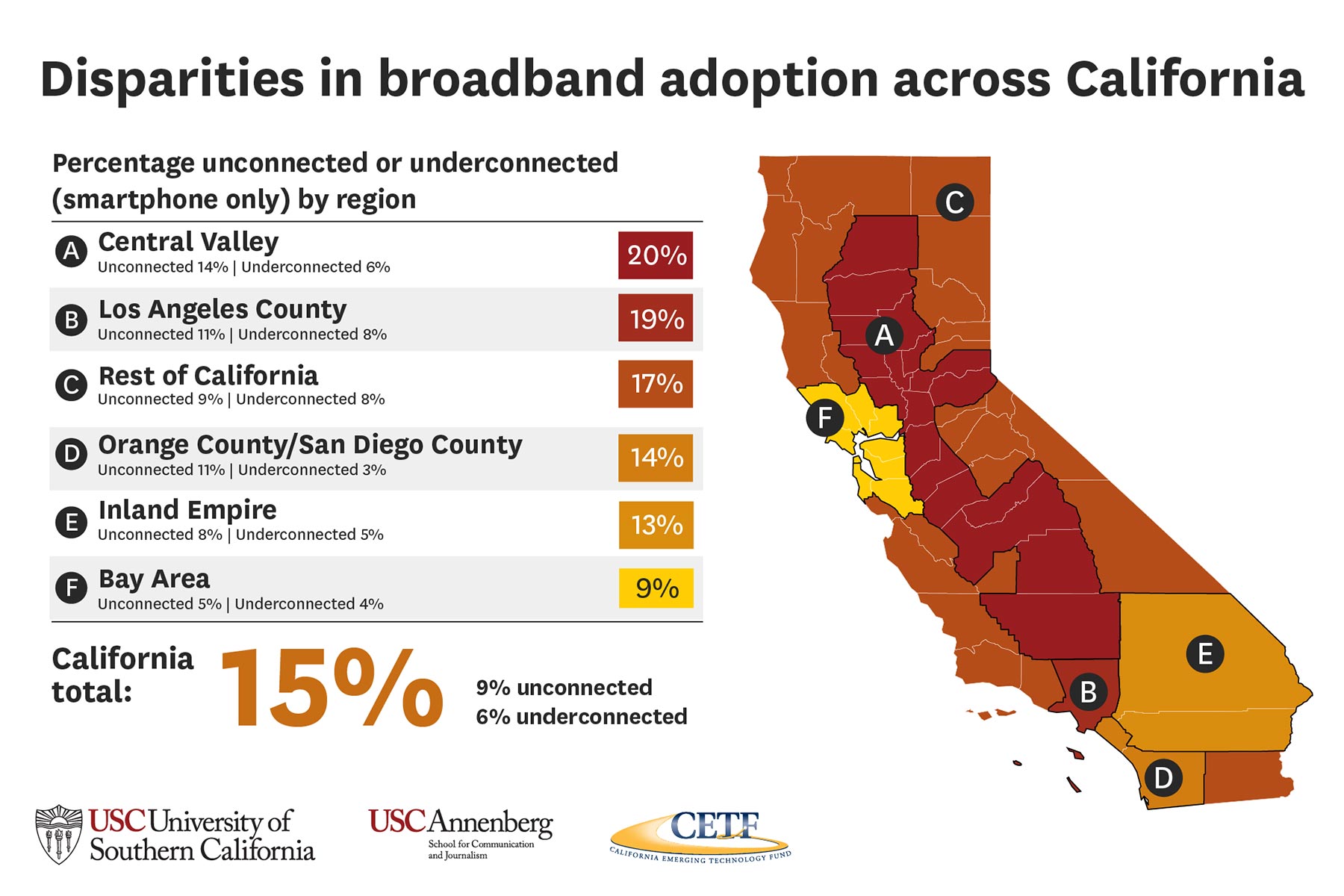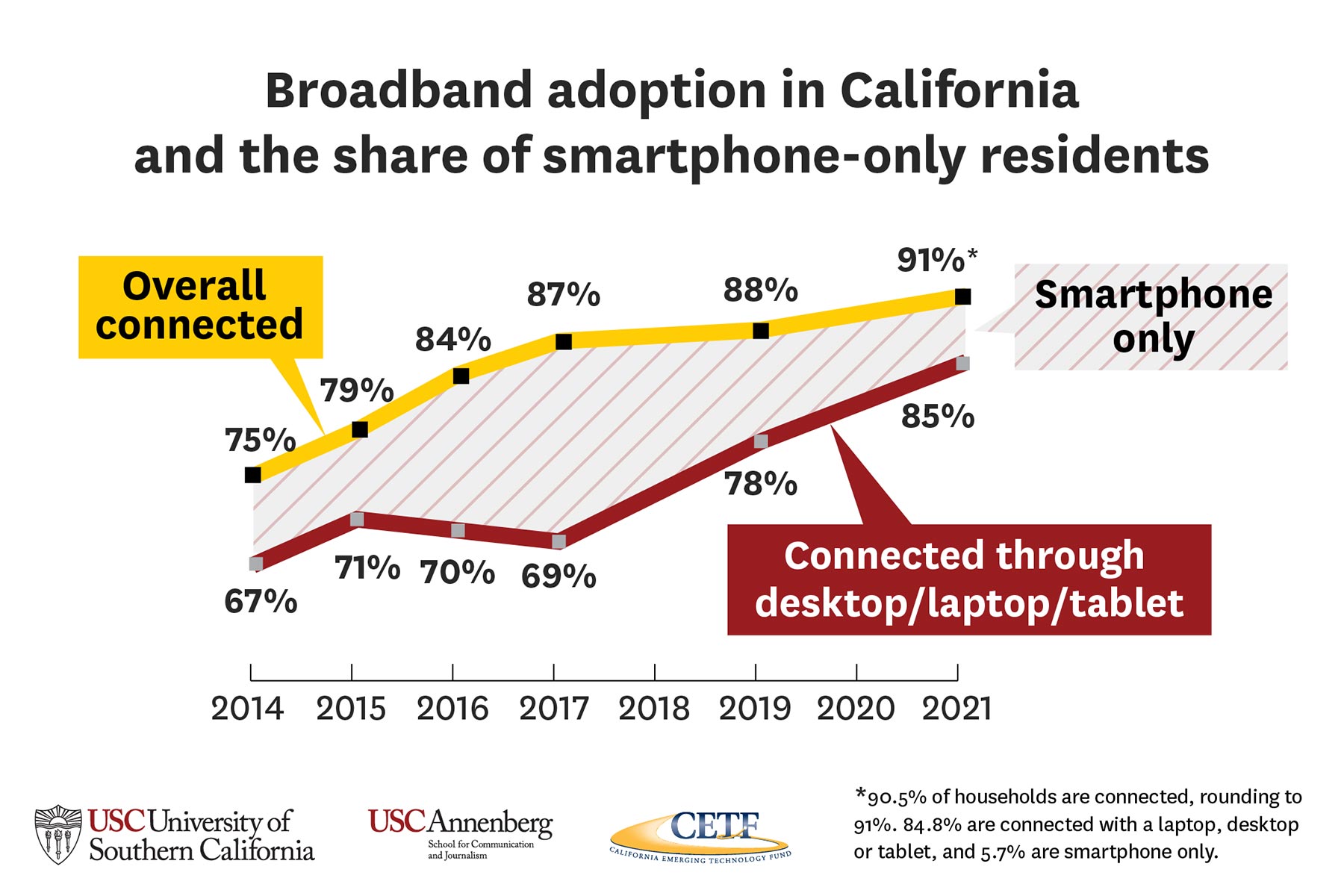
Some low-income Californians are caught in the digital divide: 16% are unconnected and 10% depend on smartphones. (Joshua Woroniecki, Pixabay)
California surpasses 90% internet connectivity, but low-income households still lack access
Amid the pandemic, a survey from USC and the California Emerging Technology Fund reveals regional and financial inequities that fuel the state’s digital divide.
California has reached a digital milestone as nearly 91% of its households have high-speed internet access, according to new statewide survey results released today by USC and the California Emerging Technology Fund.
That’s up from the 88% reported in 2019 by the biennial Statewide Survey on Broadband Adoption that monitors Californians’ digital access.
In addition, about 85% of residents — up from 78% two years ago — are using a desktop, laptop or tablet to connect to the internet. And fewer households — 6%, down from 10% two years ago — rely solely on smartphones to connect to the internet. Households linked via smartphone are deemed “underconnected” by researchers and policy analysts because smartphones have more limited capabilities.
 Despite these gains, the latest survey also reveals that some low-income Californians are caught in the digital divide: 16% are unconnected and 10% depend on smartphones. They lack home internet just when schools, jobs and even medicine have moved their services online in response to the coronavirus pandemic.
Despite these gains, the latest survey also reveals that some low-income Californians are caught in the digital divide: 16% are unconnected and 10% depend on smartphones. They lack home internet just when schools, jobs and even medicine have moved their services online in response to the coronavirus pandemic.
“The pandemic has renewed attention to the digital divide,” said Hernán Galperin, the study’s lead researcher and an associate professor at the USC Annenberg School for Communication and Journalism. “We have a unique window of opportunity to reach the goal of full broadband adoption.”
This year’s survey is the first conducted jointly by USC and the California Emerging Technology Fund, a nonprofit foundation with the mission of closing the digital divide. The fund has been tracking Californians’ internet connectivity since 2008.
California internet access survey reveals income’s role as a digital gatekeeper
California has the highest number of people living in poverty of any state, despite having the fifth-largest economy in the world. Income is a key determinant in whether a household has internet access. A closer look at the survey results through the lens of income shows that 29% of households earning less than $40,000 a year have no internet connection or only have access through a smartphone.
Residents earning less than $40,000 a year had made progress in internet connectivity from 2014 to 2019, according to prior surveys, but the latest results indicate that the progress has slowed. School, business and public library closures during the pandemic have likely further hindered their connectivity.
We have a unique window of opportunity to reach the goal of full broadband adoption.
Hernán Galperin
Low-income households often had to make tradeoffs, even before the pandemic. Throughout the past year, many workers lost their jobs either temporarily or permanently, forcing them to forgo services to save money. That includes disconnecting internet service: Nearly 1 in 5 low-income households in the survey that currently have access reported going without internet for extensive periods. Respondents also cited cost as the main reason for disconnecting their service.
Some internet service providers offer affordable plans for certain populations — primarily low-income families with school-age children — but those programs are not widely known: 2 out of 3 unconnected and smartphone-only households in the survey were unaware of these opportunities. The offers can be difficult to access, especially for anyone who does not speak English. And some families cannot afford service even with the discounts.
 “As going digital is a way of life, we are encouraged to see that overall internet adoption is increasing,” said Sunne Wright McPeak, president and CEO of the California Emerging Technology Fund. “Still, far too many Californians are up against a wall of poverty. From our work in education and telehealth, we know home internet is a catalyst for expanding opportunity for all Californians. It’s time for leadership from the highest levels of government and business to crush the wall of poverty,”
“As going digital is a way of life, we are encouraged to see that overall internet adoption is increasing,” said Sunne Wright McPeak, president and CEO of the California Emerging Technology Fund. “Still, far too many Californians are up against a wall of poverty. From our work in education and telehealth, we know home internet is a catalyst for expanding opportunity for all Californians. It’s time for leadership from the highest levels of government and business to crush the wall of poverty,”
Notable regional, demographic disparities in access
The statewide findings show additional inequities in internet connectivity persist across regions and various demographic groups. Among the most significant findings:
- The digital divide is both an urban and a rural issue: 19% of L.A. County and 20% of Central Valley households either have no connection or rely on smartphones.
- Nearly a quarter (24%) of Hispanics are unconnected or restricted to smartphones. Other groups are more connected. For example, only 5% of whites are unconnected and only 4% of them are limited to smartphones.
- Digital inequity is greatest among Hispanics who only speak Spanish. Just 65% are connected while 25% have no connection and 10% rely on smartphones.
- Twenty-three percent of Californians ages 65 and older lack broadband, compared to an estimated 10% of Californians ages 50 to 64 and less than 5% ages 18 to 49. However, when including smartphones, 77% of seniors 65 and older are connected, an improvement from 68% two years ago.
- Twenty-seven percent of people with disabilities are unconnected or connected only via smartphone, compared to 15% of the overall population.
“There are still some challenges on the road to digital equity,” Galperin said. “There’s no guarantee that the emergency measures taken to shore up access to the internet and devices will continue after the pandemic, while those still left behind may be the hardest to connect.”
 USC and the fund will release more results in the coming weeks that will focus on access to telehealth and distance learning.
USC and the fund will release more results in the coming weeks that will focus on access to telehealth and distance learning.
“The partnership between the California Emerging Technology Fund and USC is providing vital data and timely information to inform public policy and drive action,” said Barbara O’Connor, chair of the fund’s Board of Directors.
For over a decade, California internet access survey measures digital inequity
The Statewide Survey on Broadband Adoption has been conducted annually or biennially since 2008. This year’s survey of 1,650 California adults was conducted from Feb. 10 to March 22 in English, Spanish, Mandarin and Vietnamese, with 94% of interviews conducted via mobile phones and 6% via landline to reflect patterns in the population. The overall sample error is plus or minus 2 percentage points with a 95% confidence interval. The survey results are weighted for age, gender, race/ethnicity, education and region based on totals from the American Community Survey.
Data are broken down between those who rely on a smartphone for connectivity (and thus will have more limited capabilities) and those who access the Internet through a desktop computer, laptop or tablet.
Researchers from across the university will converge to analyze and interpret results of the survey, including Stephen Aguilar and Dean Pedro Noguera of the USC Rossier School of Education; François Bar, Geoffrey Cowan and Adam Clayton Powell of USC Annenberg; Donna Benton and Kathleen Wilber of the USC Leonard Davis School of Gerontology; Conyers Davis of the USC Schwarzenegger Institute for State and Global Policy; Manuel Pastor of the USC Dornsife College of Letters, Arts and Sciences; and Dorian Traube of the USC Suzanne Dworak-Peck School of Social Work. Former State Treasurer and Controller John Chiang, past fellow at USC Dornsife’s Center for the Political Future, also is a contributing researcher.



